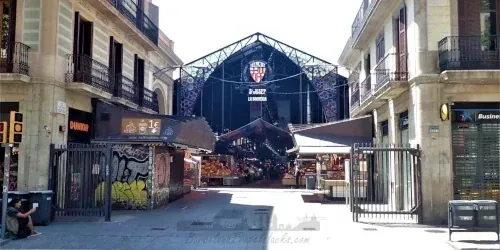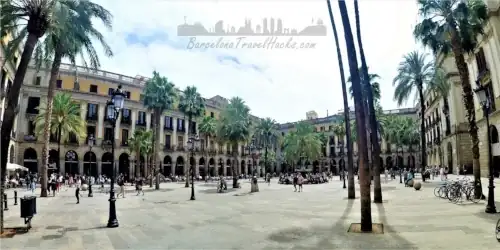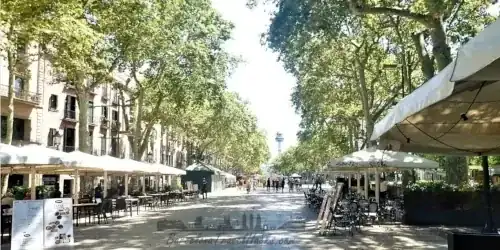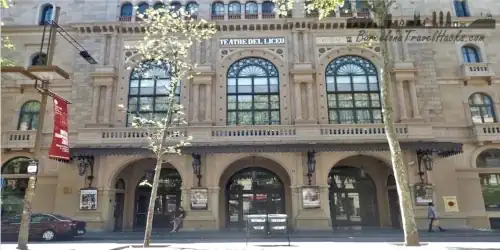Warning: Undefined array key "HTTP_ACCEPT_LANGUAGE" in /home/barcjkkl/public_html/App/Config/MySQL/language.php on line 32
Deprecated: explode(): Passing null to parameter #2 ($string) of type string is deprecated in /home/barcjkkl/public_html/App/Config/MySQL/language.php on line 36
Palau Güell Antoni Gaudí castle themed Palace
Eusebi Güell mansion museum by architect Antoni Gaudí & restored in 2011. Tickets and info for visits. UNESCO World Heritage Site
About Palau Güell Medieval Style Antoni Gaudí House
Palau Güell, Barcelona is located on the corner of La Rambla with Nou de la Rambla and was an urban residence built from 1886 to 1890 for the family of Eusebi Güell (industrialist, politician and patron of the arts). it is the second the second noble house by Antoni Gaudí, the first being Casa Viçens in Gracia.
The first thing you notice is the Palau Güell façade which takes a lot of inspiration from a medieval castle wall with overhangs and portcullis style ornate grate gates set into the parabolic arches. The gates swing open and are not drawn upwards. The ornate ironwork of the gate and the interpretation of the Güell coat of arms between the gates has a dragon perched on top. This is Sant Jordi´s dragon from the saint George legend. Sant Jordi is the patron saint of Catalonia and dragons feature heavily in Gaudí´s work.
The gates are for carriage access into an interior space where guests could alight directly onto the staircase up to the first floor and the carriages could be brought round and the horses stabled in the basement.
As well as a visual masterpiece, Gaudí solved an engineering challenge of how to build a large palatial noble home on a footprint of only 18 metres deep and 22 metres wide. he did this by building vertically and each floor has a purpose that follows the layout of a medieval castle keep. The basement and ground floor are purely for horses and stables with the stairs leading up to the noble floor. The ground floor has a spiral ramp down to the basement which was specifically to lead the horses into the subterranean stable. The basement was also the servants quarters.
The first floor (noble floor) features a grand reception hallway with huge windows out onto the street making this space very luminous. Off this reception hall is a smoking room. The reception hall leads into the main lounge area with pipe organ, a space for entertaining guests and side rooms containing grand piano and a dining room.
The second floor is for the accommodation of the Nobel family with bedrooms and private bathrooms. An interesting feature of the bedrooms is that the lounge is actually two floors high with the bedrooms on the floor above being arranged around the lounge. There are peep holes that open from the bedrooms to look down at how the guests were dressed so the family could greet their guests appropriately dressed after adjusting their attire accordingly.
The roof terrace features twenty Gaudí colourful chimneys decorated with coloured tile shards (trencadís) and has a spire with windows in the middle that illuminates the lounge via skylights. Also there are some servants quarters in the attic. Note the Sant Jordi dragon weather vane at the top of the spire.
Thought the Palau Güell visit you will see many period pieces of furniture. Gaudí was not only the architect for the building but also designed the fixtures and fittings plus a large amount of furniture.
Palau Güell was the first commission for Antonio Gaudí from Eusebi Güell and this house was built to link the existing Güell home in Las Ramblas with the new palace in Nou de la Rambla via a secret passage. This passage today is blocked but you can see what remains when you visit.
Palau Güell along with Gaudí's first grand house, Casa Viçens share similar influences of Oriental and Arabian themed rooms as well as the usual Gaudí nature inspired decorations. Both these houses have a boxy construction unlike his later two houses in Passeig de Grácia that have nature inspired wavy flowing lines.
Palau Güell was granted UNESCO World Heritage status in 1984.
In 2004 Palau Güell closed to the public for extensive renovation works including replacing some of the original stone because of cracks that were causing structural problems within the building. Restoration work was completed in April 2011.
Image Gallery for Image Gallery For Palau Güell Medieval Style Antoni Gaudí House
Click on any of the 58 images to open full screen gallery player
Visiting Palau Güell Medieval Style Antoni Gaudí House
The whole building is open to the public as a museum. This includes the basement stables, First floor reception and lounges, Second floor bedrooms and bathrooms and the roof terrace.
Tip: The audio guide is included in the ticket price and comes in multiple languages but does not include headphones so take your 3.5mm jack headphones to avoid having to hold it to your ear to use the tiny inbuilt speaker.
Is Palau Güell worth a visit?
Yes, yes and yes! Firstly, unlike the two Gaudí houses in Passeig de Gràcia, the whole building is open to the public, not just one floor and the roof terrace. The price is also less than half that of the two Passeig de Gràcia houses.
I recommend Palau Güell, Torre Bellesguard and Casa Viçens as Gaudí on a budget attractions and represent the best value for money in terms of what is open the the public and the amount of visual intrigue and splendor.
- Summer: 1st April till 30th September: 10:00h to 20:00h every day except Mondays.
- Winter: 1st october till 31st march: 10:00h to 17:30h every day except Mondays.
- The ticket office next to Palau Guell closes at 19:00h in the summer and 16:30h in the winter.
Palau Güell Opening hours
Other Gaudí Works
For The grandest of Gaudí's works in Barcelona, visit La Sagrada Família.
The House that Gaudí Lived in, is located in Parc Güell but not included in the Sagrada Família ticket. I recommend buying a combined Parc Güell + Gaudí House Museum ticket. Details on the Parc Güell Page.
My recommendation is to combine a visit to Casa Batlló with Casa Milá/La Perdera because they are only 500 metres apart in Passeig de Grácia.
You will also find Gaudi's Casa Viçens in the Gracia Neighbourhood and Torre Bellesguard in the Sant Gervasi Neighbourhood.
Each of these Gaudí wonders are visually distinct and each one its own masterpiece.
What to take with you for What to take with you for Palau Güell Medieval Style Antoni Gaudí House
The tour of Palau Güell is accessible to people who use wheelchairs. There is an elevator that connects the various floors. However the roof terrace is only accessible via stairs. Wheelchair loan service for anyone who needs a chair that is narrower than the 60 cm elevator door. The basement is accessible via spiral ramp that is probably not suitable for wheelchairs (it was designed to bring horses up from the basement stable to ground level).
A baby carrier will be offered for this with small children in push chairs.
You will be denied access with large rucksacks, bags and other over sized items so only attend with small bags.
There are no bicycle anchorage points outside Palau Guell. Bicycles in this part of town have a high probability of being stolen.
Don't forget headphones for the audio guide.
Tickets for Palau Güell Medieval Style Antoni Gaudí House
Getting to Palau Güell Medieval Style Antoni Gaudí House
Address: Carrer Nou de la Rambla 3-5, Barcelona, 08001
Nearest TMB METRO is Drasanes or Liceo, Both on the green (L3) Line. Use a T-Casual or Hola-Barcelona travel card.
Map for Palau Güell Medieval Style Antoni Gaudí House
Weather for Palau Güell Medieval Style Antoni Gaudí House
Where to stay overnight near Palau Güell Medieval Style Antoni Gaudí House
4 Nearby Attractions to Palau Güell Medieval Style Antoni Gaudí House

La Boquería Sant Josep Food Market on Las Ramblas
The oldest and most famous food market in Barcelona located in Raval and las Ramblas. Market is surrounded by small tapas bars and restaurants
Read more >

Plaça Reial Grand square with Gaudí Lamp Posts
Grand Plaza on site of former monastery, built 1848. Known for nightlife, restaurants, Antoni Gaudí lamp posts & Font de les Tres Gràcies fountain
Read more >

Las Ramblas Boulevard with Living Statues and flower stands
Tree lined pedestrian street running between Raval & Gòtic neighbourhoods, from Barcelona Port to Plaza Catalunya, Known for its living statues & kiosks
Read more >
